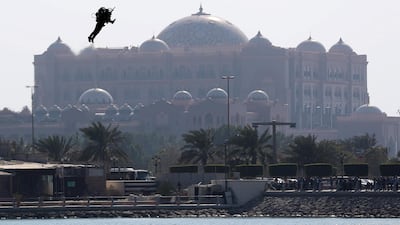It was a scene straight out of the movies.
Except the man free-flying over the Abu Dhabi Corniche with nothing but a black backpack and a remote control in each hand was not a character from a fictional, high-tech world inhabited by Iron Man or James Bond.
Australian entrepreneur David Mayman took to the skies at a speed of about 60 miles per hour as the crowds gathered to watch the 11th Red Bull Air Race World Championship in Abu Dhabi.
Mr Mayman has spent the past 12 years refining the technology for what he describes as the world’s first personal use vertical take-off and landing aircraft.
He demonstrated the latest model of his company’s JB JetPack for the first time in the UAE on Saturday.
Wearing a flying jumpsuit, helmet and the jetpack that holds two engines strapped to his back, Mr Mayman flew at a height of about 60 feet over the water wowing thousands of spectators who lined the Corniche breakwater.
“I was like, ‘It looks like a drone,’” said Netanye Nash, a 30-year-old South African teacher who watched from shore.
“And I was like, ‘No, it’s a man, and he’s flying!” said Zeenat Patel, 37, also a South African teacher.
“In what times are we living now where people are actually flying in front of us? Who would have thought that you could fly by yourself, not in a plane?”
Mr Mayman said he has been fascinated with flying ever since he learned to pilot a fixed-wing aircraft at the age of 16. He later learned to fly a helicopter.
_______________
More from the Red Bull Air Race:
Time frame: 10 years of Red Bull Air Race
WATCH: Taking to the Abu Dhabi skies for the Red Bull Air Race
Red Bull Air Race is flying back to Abu Dhabi
_______________
“But I always had a dream about vertical take-off and landing,” said Mr Mayman, 54, chief executive and principal pilot of JetPack Aviation.
“It starts off as being really frightening,” Mr Mayman said of the experience.
“There’s a lot of power, you’re talking about the power of a Nascar or Formula One car that’s sitting on your back. You can feel that. And then after maybe 25 flights, you get relaxed and it feels amazing, it’s like a magic carpet. It’s very balanced, it’s very stable and as you accelerate, the world just disappears.”
The Jet Pack Man was one of a several acts at the annual air race staged over the Corniche.
American pilot Michael Goulian, 49, took first place in the first race of the Red Bull Air Race World Championship 2018 following a nine-year drought with a time of 00:53:695.
"It's one of those things that after a while you start to doubt yourself," said Mr Goulian.
"But then you also have to look inward and make sure that you're doing everything that is competitive. You just have to figure out how to be more consistent on the highest level possible to win the race."
The Abu Dhabi air race is the first in a series of eight Red Bull Air Races held around the world annually. The next race will be staged in Cannes, France in April.
A performance by the Red Bull Skydive Team Wing Suit Jump, acrobatic jets from the Al Fursan team and Pal Takats Paramotor Aerobatics took turns thrilling the crowds in-between the daredevil races.
Mr Mayman said he followed his dream when he sold his software company and decided to focus on developing the technology to power the vertical aircraft for personal use.
He successfully tested the first prototype designed by his company 12 years ago.
The latest version of the jetpack is a long way from the models he tested years ago.
“It’s gotten smaller but also far more sophisticated,” said Mr Mayman. “Twelve years ago there were massive engines and they didn’t work very well because of the technology. They were very inefficient, they used a lot of fuel. Frankly, they weren’t very safe.”
A challenge for the engineers was making the two or four engines that powered a jetpack start simultaneously and operate in coordination.
“What would happen then is the jetpack would either try and roll one way or try and roll forward or you could have a flameout, in which case you lose thrust completely from one of the engines,” he said.
Testing the jetpacks is done on a tethered line supported by two beams. But when he flies in public demonstrations, there are no safety mechanisms in place in case something goes awry.
“The one thing that we need to incorporate is a safety system that can work at any altitude,” said Mr Mayman. “We don’t run a safety system at the moment. It’s really expensive to do well. There are lots of off-the-shelf parachute systems that we could buy, but we want to build it from the ground up, so that’s a key hurdle that we need to get through.”

